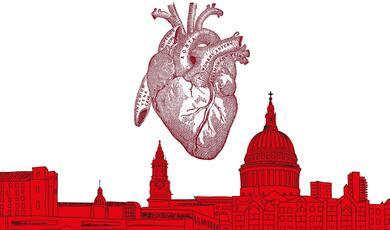Pathogens and parasites; plagues and pandemics
Share
- Details
- Transcript
- Audio
- Downloads
- Extra Reading
The earliest gains in life expectancy were made by understanding infectious diseases, first through epidemiology and then through microbiology. So what processes govern the spread of infections in populations? Why do some pathogens come and go while others are very persistent? Why are we facing new threats from BSE, SARS and bird flu, and how worried should we be?
Download Transcript
Pathogens and parasites, plagues and pandemics
Christopher Dye, Gresham Professor of Physic, 19 October 2006
It's the 3rd of October 2006. The World Health Organization has reported that a virus causing severe pneumonia had infected two people in neighbouring villages in East Java, Indonesia. One village has quickly identified the cause of pneumonia as the H5N1 virus responsible for "bird flu", isolated the patient and treated her with an antiviral drug, oseltamivir, under hospital supervision. Her life hangs in the balance. She is the 69th known case of human infection in Indonesia, and 52 have been fatal, including her 11 year-old brother. A cordon sanitaire has been erected around the village to prevent the spread of infection. Chickens have been dying in the village for the past few weeks, and now they have all been slaughtered.
The case history is real, but the computer simulation you see on the screen is imaginary. It asks what might happen if these measures had not been taken. It asks what might happen if the H5N1 virus was not simply lethal to the few people who get infected now, but had also mutated to become readily transmissible among people. This model, and others like it, allow us to investigate what would be needed to prevent the next flu pandemic, by attacking infection at source. Later in this lecture I will say more about threats from new infectious diseases, and about mathematical models. Before I do that, I want to do a number of other things. First, I want to make the link between infections and parasites – my theme today – and what I said in the last lecture about the remarkable growth in human life expectancy over the past 200 years.
We could call it the Great Escape. This was a major step in bringing our environment under control. In England, we achieved food security to eliminate famine, and we eliminated malnutrition which was an underlying cause of susceptibility to infections. Then we began to understand how to control infectious diseases during the "sanitation revolution", even before understanding the microbiology. Prevention and disease control will be the subject of the next lecture. But before we talk about getting rid of infectious diseases I want, in this lecture, to discuss how, as a set of causes of illness, parasites function. What were the processes of infection that kept life expectancies in England so low for so many centuries? These are the processes that are still responsible for significant numbers of deaths today in the poorer countries of the world?
I'll divide the subject into three parts. (1) How many kinds of pathogens are there, and what kinds of diseases do they cause? There is some basic natural history here, but is also gets at the question of what we are as human beings, and why we suffer from infections. (2) How do pathogens spread and persist? How do the principles of epidemiology explain parasite lifestyles? (3) What epidemics will we face in future? What are "the coming plagues"? Broadly speaking, the three topics are: biology and natural history, biology and maths, and biology and forecasting.
Part 1. Parasites and diseases
We talk about kinds animals mostly in terms of species, but thedomain is the top-level grouping of organisms in scientific classification. We've been classifying living organisms scientifically since Linnaeus in the 18th century, but the three-domain system was invented as recently as 1990, by Carl Woese. The reason is that that two groups previously lumped together as prokaryotes, the Archaea and Bacteria are now known to be more different from each other than they are from all other living organisms – the eukaryotes.
The Archaea are ancient bacteria, and consist of one cell. They are sometimes called extreme bacteria because they tend to live in extreme habitats, like hot springs or salt pans. And they can do very strange things metabolically, like producing methane. From what we know so far, very few are parasitic on other organisms. So we need say no more about them here.
The second group are bacteria. They also consist of one cell, and have adopted very many different kinds of lifestyles. Some are parasites, but many are also mutualists i.e. they have mutually beneficial interactions with other organisms, like us, which are often their physical hosts.
The eukaryotes (eu - true, karyote - with a nucleus and other cell organelles) have one cell or many. They include all animals, plants, protists and fungi. Here we are interested in protozoa (malaria), fungi (ringworm), worms (hookworm, roundworm, tapeworm), and in insects (mosquitoes), arachnids (ticks). In short, there is a huge diversity of living organisms that have adopted some sort of parasitic lifestyle, ranging across two of two of the three domains of life.
The number of species of organisms described is in the range 1.0-1.5 million, most of which are insects (and most of these beetles). Estimates of the true number of species range from 4-40 (or up to 100) million, depending upon the method used for estimates. Many of these undescribed species will be single- or multi-celled parasites.
But there are non-living agents that also operate as parasites. Viruses are simply pieces of genetic materials in a protective protein shell. They cause diseases such as haemorrhagic fevers, measles, polio, cancers of the cervix and liver, and so on. Prions are just infectious protein particles. They include the transmissible spongiform encephalopathies (TSEs), among which are Creutzfeld-Jakob disease and its variants (kuru, vCJD), and bovine spongiform encephalopathy (BSE or mad cow disease). Finally, taking dependency to its extreme, you can be parasitized by your own DNA. Transposons are mobile genetic elements that can cause heritable disorders like hemophilia, severe combined immunodeficiency disease (SCID), porphyria (blood and bone marrow malfunction arising from failed heme production), and cancer. So the wide variety of parasites includes both living and non-living agents
My last introductory point is that we live in intimate association with many of the organisms that can make a living on us. In one sense, people can be thought of as super-organisms consisting mostly of bacteria. We have about a trillion functional cells in our bodies. That's about the same as the number of bacteria on our skin. In our guts, there may be as many as 100 trillion bacteria, of 1000 species, with maybe 1000 times as many genes. It's a jungle in there! The biology of our guts is bound up with the biology of these bacteria. They could make their living as parasites or as mutualists – they could be beneficial or they could be harmful, depending on where the opportunities and advantages lie. Have you ever wondered why broad-spectrum antibiotics cause upset stomachs? It's napalm in a rain forest.
Most of the time we have a mutualistic relationship with Bacteroides – they help to break down food products and supply some vitamins and other nutrients that we cannot make ourselves. The problem withBacteroides is when they get out of the intestine and into our bodies. One of the most common results of this is an abscess, which is a big ball of puss comprised mostly of bacteria (especially B. fragilis). If the ball breaks then billions of bacteria spread throughout the body often resulting in death.
There is therefore a fine line between the power of partnerships and the perils of parasitism.
Our relation with Bacteroides is a largely beneficial association that sometimes goes wrong. I'll give you one other example of where the same kind of organisms, given different opportunities, has adopted different lifestyles. Vibrios are bacteria best known for causing cholera. One of the centres of diversity of Vibrios is the Ganges delta – which is a sort of Vibrio soup. To cause cholera, Vibrios have co-opted gene clusters from viruses (called phages) that infected these bacteria long ago. These gene clusters have been dubbed "pathogenicity islands". In these islands, V. choleraehas acquired genes that do two important things: (a) they have receptors so that phage can be delivered to host cells ensuring effective transmission, and (b) there is a toxin causing massive fluid loss, the diarrhoea that aids transmission.1,2 This is an age-old conspiracy between a bacteria and a virus. But the related V. fischeri does something totally different - it has formed a remarkable mutualistic relationship with squids in which it is responsible for the function of the light organs that they use to find their prey in the dark.
Out of all this diversity, and all these possibilities, how many organisms are actually parasitic on humans? Excluding insects and ticks, the answer is only about 1400, out of many thousands of possibilities (according to recent review by Louise Taylor and colleagues in Edinburgh). Around a half (800-900) have their main life cycles in animals, but we acquire them by cross-transmission.3 175 were designated as "emerging" – the causes of new plagues – and I'll have more to say about those in the final part of this lecture.
These parasites all cause recognized diseases. But which cause serious human disease and where? In the last lecture I showed you this picture of the distribution of disease in low- and high-income countries, and I pointed out that most illness and deaths from infections are in low-middle income countries.
About 13m of the 60m deaths each year are due to infections. Despite the huge diversity of parasites, most deaths are due to a small number of bacteria and viruses. Here are the top 12 causes of death from infections worldwide. 86% of deaths are due to just 5 conditions, including AIDS, TB and malaria, each cause by essentially one parasite. 90% of acute lower respiratory infections are pneumonia, mostly in children, and caused by a few bacteria (Streptococcus pneumoniae, Haemophilus influenzae) and viruses (respiratory syncytial virus). Similarly, severe diarrhoea is caused by a few bacteria (E. coli, V. cholerae, Campylobacter, Shigella), viruses (rotavirus), aided by some single-celled protists (Giardia,Entamoeba) and worms (Strongyloides), and abetted by nutritional deficiencies (zinc, vitamin A). And as I shall explain in the next lecture, groups of agents causing pneumonia and diarrhoea can in principle be dealt with by a few, cheap interventions – a mixture of antibiotics, vaccines, and sanitary and hygiene measures.
To summarize this first section, we live in contact with many different kinds of organisms that have the potential to become parasites. Only a small proposition have become parasites. And the good news for public health is that, among those that have indeed adopted parasitism as a lifestyle, very few are major causes of human death.
Part 2. Parasite spread and persistence in populations. To make sense of biological diversity we have to organize it. There are many approaches to classifying the ways that organisms can make a living on humans. My interest is in how they persist in populations, so in this next section I want to take an epidemiological view of the kinds of parasite lifestyles that can be successful.
Epidemiology is an explicitly mathematical subject. We're going to do a bit of maths in this section, so I need to make clear my stance on mathematical models. Here are three commentators with whom I broadly agree. "All that is simple is false and all that is complex is useless" (P Valéry). "Everything should be made as simple as possible, but not simpler" (A Einstein). And then there's the sentiment expressed by the question: "Why replace a world you don't understand with a model of the world you don't understand?" (P Richardson & R Boyd).
And of course Picasso had his own way of saying these things. To draw a bull is to make a conceptual model of it. I'm operating somewhere in the middle of this picture. I want to know it's a bull, but I don't want to lose sight of the essential features of a bull.
Here, then, is the (moderately) simple maths of epidemics. There are two things that parasites have to be able to do: reproduce and spread through populations, and then persist in those populations (or move in to others). Notice that epidemiology, like evolution, is not primarily about the "survival of the fittest" (in Herbert Spencer's words), but rather about differential reproductive success. In this diagram, the epidemic spreads because, in the early stages, each case gives rise to more than one other case on average. We say that the basic case reproduction number, R0 = 15/9 = 1.8 (>1). But sooner or later the epidemic wanes because the pathogen runs out of hosts – it has either killed them (e.g. rabies) or they have become immune (e.g. measles). Using up hosts slows the epidemic, the case reproduction number falls below 1, and the epidemic dies away unless it is fed with more susceptibles. Notice that this slowing of the epidemic protects some of the people who have not yet been infected, and never will be infected. They are protected, not because they are intrinsically resistant to infection, but because of "herd immunity", a concept that is fundamental to the control of epidemics.4
These basic facts about epidemics highlight the second key problem faced by parasites: persistence and survival. I'm going to talk briefly about four kinds of survival strategy: (1) in a single host (measles), (2) via resting stages (latency) in a single host (TB), (3) in animal reservoirs (plague), and (4) in environmental reservoirs (cholera).
The epidemic on the cover of that textbook died away because it was not fed with any new hosts. For an exclusively human disease like measles, which spreads quickly but where people have lifelong immunity after infection, the only sources of new susceptibles are births or immigrants. For this reason, measles can't persist on small islands. The birth rate is too low in small populations, and immigrants too few.
In fact measles can only be sustained in populations that number hundreds of thousands. The mega-cities of Africa and Asia have populations in excess of 10 million and acquire more than 400,000 susceptibles each year. These susceptibles could be removed by vaccination. If they are not – as in Lagos, Dhaka and Mumbai – many children will get measles. However, if vaccination coverage is high – as in New York, Mexico City or LA – measles incidence can be kept low.5
Here in the UK, although all of the claims of serious side effects have been refuted, there has been a decline in the uptake of the MMR vaccine. This has led to a growing pool of susceptible individuals, and the drop in vaccine uptake has been followed by a number of large measles outbreaks. In 2004-05, 81% had been immunized against measles, mumps and rubella with the combined MMR vaccine, slightly higher than the 80% uptake in 2003-04, but well below the peak coverage of 92% achieved in 1995-96.
It used to be thought that human tuberculosis was acquired from cattle, after they had been domesticated maybe 10,000 years ago. In fact we did not get TB from cows in Neolithic times. Genetic analysis has recently shown that TB has probably been a human disease for millions of years. It must therefore have evolved and persisted in very small human populations. How did it do that?
My answer is that it survived by developing a latent or resting stage in people. Take a large number of school children, like these in India, and inoculate them with tuberculin, which is purified protein from M .tuberculosis. Some of them will react, indicating that they are infected, and they may be infected for many years without developing active TB. Many people in the world – our estimate is about 1 in 3 or 2 billion – are now infected with TB, a gigantic reservoir of bacteria.6 The purpose of the resting stage is to slow down the epidemic so that infection happens on the same time scale as the regeneration of susceptibles.
Sweeping through Europe in the 14th century, plague killed a third of the human population. Plague epidemics have come and gone in human populations; and they still keep coming and going. How does the plague bacillus survive? The answer some from understanding the relationship between plague bacterium, fleas and rats. "We will win" (say the inhabitants of Shoreditch).
In my last lecture I referred to John Graunt's bills of mortality. Here are some plague statistics that describe the outbreaks suffered by Londoners in the 16th and 17th centuries. Where was plague between those outbreaks?
Well, it was in rats of course, and recent mathematical modelling has shown how plague persists "below ground" in rats, while leaking occasionally into human populations.7
Lastly, the risk of disease from the environment. I said in the introduction that Vibrios live in water. Contaminated water was everywhere in Europe's major cities during the 19th century. During "The Great Stench" of 1858 it was said that "The sewage of three millions of people has been brought… to seethe and ferment… in one vast open cloaca (the Thames). Parliamentary committee rooms rendered barely tolerable…" (Winslow 1943).
Florence Nightingale, in her book, which carried the matronly title, "Notes on Nursing: What It Is, and What It Is Not", remarked evidently with exasperation, "of the fatal effects of the effluvia from excreta it would seem unnecessary to speak were they not so constantly neglected."
This was a tale not of two cities, but of many. However in Paris, the same campaign was being waged by Dr André-Justin Martin, who led the municipal disinfection service in 1890s.
So there were many places where one could investigate the epidemiology of cholera, after its arrival in Europe in the 1830s, but the major breakthroughs in understanding were made in London. In 1848-9 there was a severe epidemic in London, with 15,000 recorded deaths. In an early piece of exploratory epidemiology, William Farr found that there were more deaths from cholera in the lower areas near the river. He thought cholera was something to do with the damp air near the river. John Snow's subsequent, fuller investigation revealed the truth, that cholera came from the water supply.
Part 3. Future plagues.
The study of new, or renewed, threats from microorganisms has become a growth (or a re-growth) industry in recent years. EID is one prominent journal in the field.
Where will the threats come from and how bad will they be? Human interactions depend on the social, ecological, physical and genetic factors.8
I referred earlier to Louise Taylor's study, which included an evaluation of emerging parasites. Here is the classification.
The co-called Beijing strains of TB are more pathogenic than others. They kill mice very quickly.
They are spreading, but Beijing is unlikely to be a major obstacle to controlling the TB epidemic. A far greater problem is the application of basic procedures in diagnosis and treatment.
Hospitals are becoming more dangerous places. It's not certain quite death to visit, say, King's College Hospital but …
Staph infections, including MRSA, occur most frequently among persons in hospitals (plus nursing homes, dialysis centers etc) who have weakened immune systems. These healthcare-associated staph infections include surgical wound infections, urinary tract infections, bloodstream infections, and pneumonia. Staph and MRSA can also cause illness in persons outside of hospitals and healthcare facilities. The main mode of transmission of staph and/or MRSA is via hands which may become contaminated by contact with infected individuals; devices, items, or environmental surfaces contaminated with body fluids containing staph or MRSA. Other general factors contributing to transmission include skin-to-skin contact, crowded conditions, and poor hygiene.
Emerging and re-emerging zoonoses. Which of these many outbreaks could turn into pandemics?
What are the characteristics of major pandemics? (1) Unavoidable transmission route. (2) Highly infectious. (3) High proportion of people exposed. (4) Transmission rapid compared with response time (everyone gets infected before knowing). (5) Fatal. We'll look at two pathogens with these characteristics, one that moves quickly and the other slowly.
One of the fears in this "globalized" world. Is that infectious diseases will be rapidly transmitted via the ever-growing airline networks.9 This is a map of the airline traffic among the 500 largest international airports in over 100 cities. The brighter the colour, the more passengers per day. What is clear is the intense movement within North America, Europe and Eastern Asia, and also between these regions. That is how SARS spread from China to Hong Kong to Canada. A recent study in the USA found that the usual influenza season was markedly delayed following the attacks on 9/11 (11 Sep 2001).
Severe Acute Respiratory Syndrome (SARS) was the warm-up for the next flu pandemic. The virus appears to be spread most commonly by person-to-person contact involving exposure to infectious droplets, and possibly by direct contact with infected body fluids. SARS triggered a global health crisis after emerging in China's southern Guangdong province in November 2002. Probable cases have been reported in 17 countries causing nearly 800 deaths, including 349 in China, with a case-fatality rate of 4%. Bats are the natural hosts. SARS was contained; and we're now preoccupied with greater fears about bird flu.
Here is a map of the distribution of avian influenza. Pale orange is the distribution in wild birds; dark orange is the range of infected poultry. The dots show the sites of confirmed human cases. The current outbreaks of highly pathogenic avian influenza began in South-East Asia in mid-2003 and are the largest and most severe on record. Never before in the history of this disease have so many countries been simultaneously affected, resulting in the loss of so many birds. Despite the death or destruction of an estimated 150 million birds, the virus is now considered endemic in many parts of Indonesia and Viet Nam and in parts of Cambodia, China, Thailand, and Laos. Control of the disease in poultry is expected to take years; eradication may not be possible. Domestic ducks can excrete large quantities of highly pathogenic virus without showing signs of illness, and are now acting as a “silent” reservoir of the virus, perpetuating transmission to other birds. When compared with H5N1 viruses from 1997 and early 2004, the H5N1 viruses now circulating are more lethal to experimentally infected animals, and survive longer in the environment. H5N1 appears to have expanded its host range, infecting and killing mammalian species previously considered resistant to infection with avian influenza viruses. Among 256 human cases reported to WHO by October 16, 151 have died.
Type A viruses have subtypes defined by two surface proteins: 15 subtypes of hemagglutinin (H) and 9 subtypes of neuraminidase (N). The virus can improve its transmissibility among humans via two principal mechanisms. The first is a “reassortment” event, in which genetic material is exchanged between human and avian viruses during co-infection of a human or pig. The second mechanism is a more gradual process of adaptive mutation.
How big will the next flu pandemic be? Some scientists have tried to assess this by re-running the 3 pandemics of the 20th century under contemporary demographic conditions. The conclusion – it can be no other – is that we do not know. We will not know until we understand the transmissibility and virulence of the H5N1 virus (if that is the formula). Vigilance is the key.
The worst scenario in a flu pandemic – of a rapidly-transmitted, very virulent virus – is very bad indeed. Here are some tips on how to survive it, borrowed from New Scientist.10
In the worst scenario, bird flu has the characteristics of a disease that could kill many people and disrupt society. AIDS has had the same effect in some parts of the world, especially Africa, and is the real pandemic of our times. We've just commemorated 25 years of AIDS. It was in 1981 that a new immune deficiency disease was recognized in gay men in the USA.11 Now there are 40 million people infected with HIV worldwide, and most have acquired infection through heterosexual transmission. Three million people died of AIDS in 2005, and about 25 million have died during the course of the epidemic.
The variation in geographical distribution of HIV/AIDS is stark, from 0.1% of adults in eastern Asia to 15% and higher in southern Africa. AIDS has not been controlled for various reasons: it is transmissible by a route that proved hard to avoid, it has a long incubation period of 10 years (so much transmission goes on before there is a general awareness), and it is fatal (unless treated carefully with anti-retroviral drugs).
To conclude, parasitism has been adopted as a "lifestyle" by many different kinds of living and non-living agents. Those lifestyles present some sharp questions about the nature of us as individuals, about the boundaries between self and non-self. Our own genetic diversity is mostly that of the bacteria we live with – for some we are partners, for others we are food and habitat. We exchange heritable genetic material with them and with an assortment of viruses. Remember, too, that parasites are not necessarily other organisms: cooperation and conflict are features of our own DNA.
Taxonomists might ask why there are so many kinds of parasites; public health specialists might ask why, among the huge diversity of parasitic agents, there are so few major causes of death. The good news for public health is that these few causes of death are mostly preventable or curable – as we'll see in the next lecture.
We can't predict exactly which infections will cause the pandemics of the future.12 However, the best candidates are lethal viruses that are rapidly transmitted compared with our reaction times – like avian influenza (weeks) or HIV/AIDS (years). While the future is very hard to describe, the past is very easy. Only one pathogen of humans has ever been eradicated (smallpox); if we were ever to return to the kinds of lives we lived in the 17th and 18th centuries, with life expectancies of 30-40 years, you can bet that we would be dying from the same set of infectious diseases.
Selected references
1. Bloom BR. On the particularity of pathogens. Nature 2000;406:760-761.
2. Merrell DS, Butler SM, Qadri F, et al. Host-induced epidemic spread of the cholera bacterium. Nature 2002;417:642-645.
3. Taylor LH, Latham SM, Woolhouse MEJ. Risk factors for human disease emergence. Philosophical Transactions of the Royal Society B2001;356:983-989.
4. Anderson RM, May, R.M. Infectious Diseases of Humans: Dynamics and Control. Oxford: Oxford University Press, 1991.
5. Strebel PM, Cochi SL. Waving goodbye to measles. Nature2001;414:695-696.
6. Dye C. Global epidemiology of tuberculosis. Lancet 2006;367:938-940.
7. Keeling MJ, Gilligan CA. Metapopulation dynamics of bubonic plague.Nature 2000;407:903-906.
8. Cohen ML. Changing patterns of infectious disease. Nature2000;406:762-767.
9. Hufnagel L, Brockmann D, Geisel T. Forecast and control of epidemics in a globalized world. Proceedings of the National Academy of Sciences USA 2004;101:15124-15129.
10. MacKenzie D. The bird flu threat. New Scientist 2006;January 7.
11. UNAIDS. Report on the global AIDS epidemic (www.unaids.org). Geneva: UNAIDS, 2006.
12. Foresight. Infectious Diseases: Preparing for the Future (www.foresight.gov.uk). London: Office of Science and Innovation 2006.
© Professor Christopher Dye, Gresham College, 19 October 2006
This event was on Thu, 19 Oct 2006
Support Gresham
Gresham College has offered an outstanding education to the public free of charge for over 400 years. Today, Gresham plays an important role in fostering a love of learning and a greater understanding of ourselves and the world around us. Your donation will help to widen our reach and to broaden our audience, allowing more people to benefit from a high-quality education from some of the brightest minds.


 Login
Login







